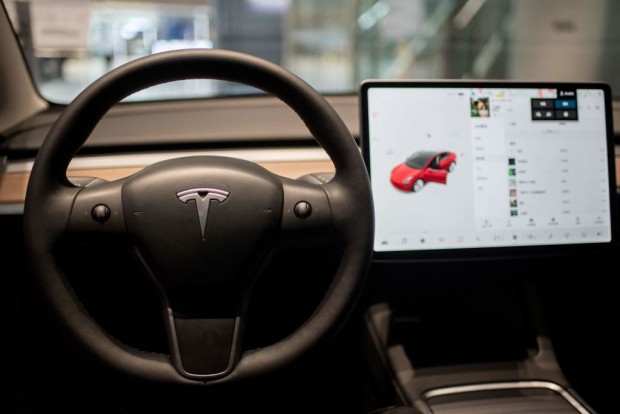The inside of a Tesla car Model 3 is seen at a Tesla shop inside of a shopping Mall in Beijing on May 26, 2021.
(Photo : NICOLAS ASFOURI/AFP via Getty Images)
A growing number of Tesla drivers have been experiencing "phantom braking" with their vehicles, according to an analysis of federal auto data by the Washington Post. The National Highway Traffic Safety Administration's Office of Defects Investigation received 107 different complaints from Tesla drivers over the past three months about their cars making random, jolting stops in response to imagined hazards.
At least 51 complaints were reported to NHTSA in November 2021 about this phenomenon, a sharp increase from 13 reports the previous month. Tesla ended 2021 with 32 more complaints about phantom braking in December. The problem persists to start the year, with 24 Tesla owners sending complaints to the NHTSA about this issue in January 2022.
Among the hazards that the Tesla cars misinterpreted were trucks in nearby lanes, oncoming traffic on two-lane roads, and trash on the road. The increase in "phantom braking" cases is alarming, considering only 34 complaints were reported regarding this phenomenon in the preceding 22 months.
Related Article: Tesla Recalls Vehicles Again After NHTSA Discovers FSD Software Lets Drivers Run Past Stop Signs
Phantom braking, a persistent issue for Tesla
Phantom braking has been a persistent problem for Tesla cars, with the world's leading electric car maker forced to recall a version of its Full Self-Driving software back in October due to false positives to its automatic emergency braking system.
According to Tesla, those false positives were triggered by a software update. However, complaints remain high regarding that issue even after the recall, signaling continued concern by Tesla owners with their vehicles.
The timing of the surge in complaints about phantom braking coincided with Tesla's decision to stop using radar sensors in its vehicles to supplement the suite of cameras that perceive the car's surroundings. Tesla made an announcement last year that it would stop equipping Model 3 and Model Y vehicles built in North America with radar starting in May 2021.
Tesla Vision to blame for the rise in phantom braking cases?
Tesla had equipped its vehicles before with eight surround-view cameras that the carmaker says "provide 360 degrees of visibility around the car at up to 250 meters of range." Tesla also leverages 12 ultrasonic sensors to help detect objects around the car. Elon Musk's company wanted to transition its fleet eventually to Tesla Vision, a self-driving system entirely dependent on just camera sensors.
The switch to Tesla Vision has caused concern among drivers and safety experts, who believe the carmaker's self-driving system started acting erratically once radar sensors were removed. Phil Koopman, a Carnegie Mellon University professor who focuses on autonomous vehicle safety, echoed those sentiments, saying, "Phantom braking is what happens when the developers do not set the decision threshold properly for deciding when something is there versus a false alarm."
Koopman added that it is harder to be sure with only one sensor type because the vehicles do not cross-check from different sensors such as radar and lidar.
READ MORE ON AWN:
Castroneves Wins Again as Meyer Shank Racing Acura Arx-05 Captures Rolex 24 at Daytona
See Now: OnePlus 6: How Different Will It Be From OnePlus 5?



























